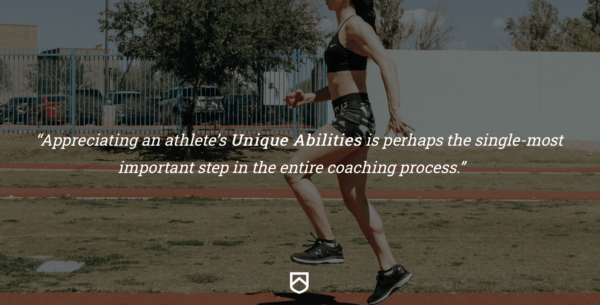An athlete’s unique abilities are those factors that co-exist and interact to form the athlete’s ‘authentic movement solution’. There are both internal and external factors that make coaching each athlete unique. Their structure, their force-producing abilities, their coordination, and their current technical understanding of the task at hand means that movement solutions are individual. Their relative levels of neuromuscular and cardiovascular levels also means that their running abilities are individual.
It is part of our jobs to understand these unique abilities, and to write training programs to take best advantage of them.
While many coaches focus on improving athletes’ weaknesses, we build our programs around athletes’ strengths. We do not ignore what holds athletes back – but we always work towards what makes an athlete unique: their strengths.
So how do we identify an athlete’s unique abilities?
Many in the industry take their athletes through some sort of ‘quantitative’ screening process early in the training year. Often this is even the very first day of training. It might be a time trial, or a movement screen of some sort.
We do not do this.
Rather, we go through a 2-3 week ‘qualitative’ process first, where we ‘live’ with the athlete – watching her, talking to her, getting to know her. Only after this process, will we move on to more quantitative methods.
These qualitative factors include asking a number of questions – some directly of the athlete, and some we ‘ask’ ourselves – in our attempt to better understand how the athlete moves:
- What kind of training has she done previously, and what does she think ‘worked’? What did she enjoy?
- What was she doing when she first felt ‘good’ at what she was doing?
- Is she comfortable with small ranges of motion, but uncomfortable and uncoordinated at larger ranges?
- Does she have trouble with slower running as compared to faster running?
- Does she move forward really well, but look like she’s always off-balance moving backwards?
- What are the shapes, patterns, rhythms, and postures she creates through all of the training menu-items?
- Does she prefer to be on the ground, rather than in the air when she runs? Is this any different to her warm-up?
- What is her energy like? Does this change when moving from the warm-up into the main session? Does it change when moving from the track into the weight room?
- Are her running mechanics different on the grass than on the track?
- What movements is she more-comfortable with in the weight room?
Of course, this list is not comprehensive, and many more questions will come about as we go through the process. We very rarely will identify the most-relevant questions to ask before we have embarked on any process. It is only once we are going through something, that we have enough information to ask the relevant questions.
While some of this first 2-3 week period is ‘structured’ training, a lot of the daily details are fluid; in effect, it is a trial & error process – where we continually place the athlete in various situations depending on what we are currently observing.
Through this process, we begin to get an idea of what makes each athlete tick — what the most-relevant training components parts should be. We begin with 2-3 high-intensity loads, and 2-3 low-intensity loads, and then begin to think about how these loads should be organized in time.
Interested in the Coaching the Endurance Events Course?
Check out one of our newest Track & Field Event Courses here!

